 |  Behavioral Statistics in Action, 3/e Mark W. Vernoy,
Palomar College
Diana J. Kyle,
Fullerton College
One-Way Analysis Of Variance
Glossary
| F ratio | is the ratio of the mean square between groups estimate and mean square within groups estimate. If the null hypothesis is true, this ratio will be 1.
|  |  |  | | F test | indicates if there is difference between at least two and possibly more of the groups such that the null hypothesis can be rejected. It does not indicate where the difference lies.
|  |  |  | | HSD | is a post-hoc test. The HSD stands for honestly significant difference. It is used to compare sample means when an analysis of variance leads to a significant F. It reveals how far apart the sample means must be in order to be significantly different.
|  |  |  | | Mean square | is a variance estimate and it is the average of the squared deviation scores used to calculate the variation.
|  |  |  | | One-way analysis of variance | is a test of the null and research hypotheses when the research design involves a comparison of three or more levels of one independent variable.
|  |  |  | | Post-hoc test | is a test performed if the F ratio is significant to determine where the significant difference(s) lie. Post hoc is Latin for "after the fact."
|  |  |  | | Source table | is a table that displays the source of variation, sums of squares, degrees of freedom, mean squares, the F ratio, and p value.
|  |  |  | | Sum of squares | is similar to the sum of deviation scores.
|
|



 2002 McGraw-Hill Higher Education
2002 McGraw-Hill Higher Education